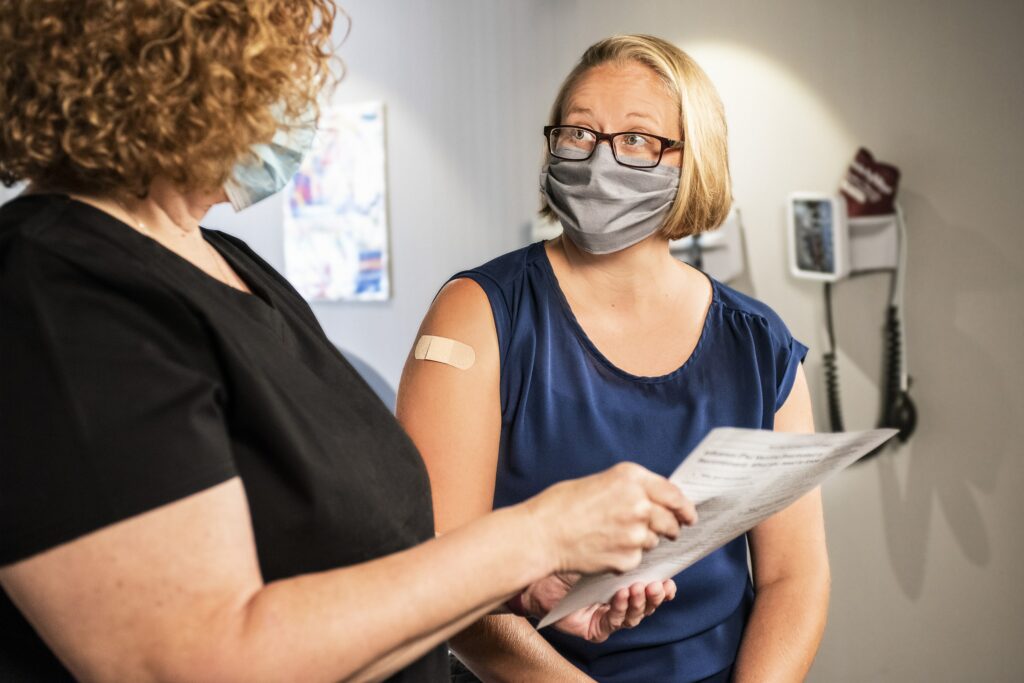Hospitals, private practices, university medical research units, and pharmaceutical labs strive year in and year out to enhance patients’ quality of life and take advantage of new and innovative healthcare options. However, the treasure trove holding most of the answers is big data (BD) emerging from patient studies, millions of health records, medicine and treatment trials, and medical device output — all accumulated, cleansed, analyzed, and inserted into AI and ML algorithms to generate groundbreaking patient care breakthroughs.
Notwithstanding, alarm bells go off every time data reliance enters the conversation, reminding us that results are only as good as the original information. After all, if the database is faulty (e.g., not extensive enough or unscientifically accumulated), the healthcare industry could embark on expensive routes and commitments that will inevitably fail.
Can the healthcare industry trust big data?
Healthcare providers have been bitten more than once by unstructured data contaminating valuable input, thus making data integrity a crucial part of taking BD to the next step of algorithm connection. However, by establishing BD governance principles and frameworks uplifting quality standards, the processes have substantially improved reliability and confidence in the results.
We cannot overstate quality control as a fundamental pillar of BD strategy, considering that disruptive processing can be potentially life-threatening if it leaks into misguided actions. In other words, working around accurate or faulty data frequently makes the difference between life and death (or sinking into a debilitating illness). To make things more complicated, even if the BD is impeccable, incompetent preparation for tech overlays to make sense of it all will doom the exercise to the same fate.
Thus, three crucial considerations in the medical arena are:
- Securing the right volume
- Verifying the data sources
- Converting BD through proven processes under the guidance of IT talent to simultaneously pass the highest quality standards practically and realistically
Failure to accomplish the above means failing patients, let alone the stakeholders behind the enterprise backing new initiatives in the post-COVID-19 digital revolution. This article goes directly to the mainstream issues in front of us to give you a transparent, no-fluff exposure to deploying BD in the healthcare arena.
So, is big data a big deal to the healthcare industry today?
A few industries in the US have the resources to harness millions of observations, even billions of them, to guarantee accuracy if the following steps adhere to proven protocols. Financial services stand out quite prominently, with entities like AMEX, Mastercard, Visa, Chase, Wells Fargo, and a range of other regional giant banks in tow.
Healthcare is another obvious example, with thousands of patient interactions every hour recorded and available for analysis. Thus, data generation emerges from electronic health records, pharmacy prescriptions, drug research tests, genomic sequencing, medical device usage, remote patient monitoring (RPM), hospital files, and physician visits. So, where does it go from there?
Healthcare and pharmaceutical organizations have energized their ecosystem with innovative solutions by deploying cloud-based data lakes that facilitate structured storage of diverse data types more compliantly, efficiently, and cost-effectively than traditional data warehouses. As a result, these participants are prolific users of advanced analytics, springboarding off BD technology by investing millions of dollars in these data repositories — far more than almost every industry. Here are just a few examples of the healthcare-big data collaboration:
- Royal Philips, a mammoth global health technology juggernaut, accumulated 390 million medical records in the cloud as far back as 2016, and converted them into actionable, relevant information.
- The National Institute of Health established Big Data to Knowledge (BD2K) to bring researchers, clinicians, and healthcare providers into the big data realm, thereby creating fast patient care, cost and information flow improvements, as well as better disease cures and prevention.
- Open PHACTS, a researchers’ platform, focuses on providing groundbreaking pharmacological data insights and unraveling complex problems in the arena.
How is the cloud helping healthcare?
The mind boggles at the challenge of managing such a data dump, which can be as useful as two left shoes if left as is. Making matters worse, it overwhelms traditional hardware or standard data management methods, begging the questions:
- Are cloud-based solutions capable of establishing a BD infrastructure and scalability?
- Can it make sense of siloed data-sets firing at us from every angle?
The short answer is: “Oh, yes, it can.”
Cloud data preparation solutions are game changers. Moreover, they’re ground zero for healthcare organizations raising their personnel’s capabilities to interact seamlessly with BD to gain valuable insights. We’ll see below that speed of understanding is vital to success in many healthcare verticals. The cloud shortens the “time-to-insight” by more than half, creating better data delivery with the audiences that counts for a faster transition to cures and more efficient treatment protocols. How is it doing this? Cloud-based integration platforms can:
- Virtually consolidate substantially diverse databases for smoother, faster processing
- Simultaneously apply data quality controls across unified databases
- Synchronize data across clinical systems, thus promoting improved patient care
6 critical ways BD is transforming healthcare
It’s common sense that advanced patient care, innovative new treatments, new medications, and startling healthcare breakthroughs we hear about on the news are not a hit-or-miss affair. They don’t arise by coincidence or some act of God. No, actionable data analysis and penetrative insight are at the core of the changes, making the lives of doctors, caregivers, and hospital administrators easier by uplifting patient care beyond expected limits.
The latter extends to applying big data analytics to accelerate efficiency, revise best practice methodologies, cut overheads, and erase wasted research from the arena. Consider the following primary data-centric benefits that healthcare participants enjoy now and into the future:
1. Better patient tracking and monitoring.
RPM solutions are nothing short of revolutionary, creating patient access seamlessly outside of typical clinical settings. All credit to tech talent that cures the torrent of raw data streaming in before overlaying innovative ML software to make sense of it all, which has substantially:
- Reduced hospital readmissions without sacrificing HC standards.
- Bolstered in-home care for patient convenience with massive cost savings.
2. Improved diagnosis
Ask any physician or specialist, and they’ll tell you that diagnostics, particularly disease ID, is head-scratcher #1. Unfortunately, when it takes too long to identify cancer, nerve diseases, diabetes, heart and lung ailments, and potential but stoppable internal disruption (that can be fatal), the patient inevitably suffers. Thus, speedy diagnosis is a vital driver of better patient care that, until now, has been somewhat elusive. This brings us to another modern concept in healthcare data-driven initiatives: Data Velocity (DV).
DV deals with the speed of creating, moving, and accessing data. It boils down to picking one’s spots to shorten delay times. For example, data-sets around readmission reports or patient collection rates aren’t all that urgent and, in any event, stream through slower. Conversely, patient vital signs require DV instant updating in real-time. Not only is the latter more urgent, the speed of data collection and analytics also helps take faster action.
Moreover, big data ML has an uncanny way of learning from past errors, highlighting the latter, and finding ways to stop them from recurring. So, disease identification is a spotlighted category that has improved in leaps and bounds. As a result, it has succeeded in prolonging lives after using predictive analytics to unearth the hidden golden nuggets in the big data mining trove to deliver life-prolonging gifts that keep coming.
3. Improved opioid addiction treatments
Fentanyl abuse is a scourge in the nation, earning the top spot in a long list of illegal drugs entering the US. It’s by far the most addictive, powerful, and deadly — a synthetic opioid that has earned the dubious distinction of being the #1 instigator of overdose fatalities in the country. Think of it this way: one gram of fentanyl can mow down 500 people, and the stuff is even creeping into mixtures of heroin, cocaine, and pills without user awareness.
In fact, CDC records show that the drug triggered 71,238 overdose deaths in 2021 alone.
Against the backdrop described above, big data is now tackling opioid abuse by spearheading an initiative to pinpoint high-risk patients. But that’s only half the story. A severe obstacle in opioid treatment is medication overdosing on a trial-and-error basis or, conversely, for the same reason, under-medicating. Finding the right balance quickly is a monumental challenge, because you want to avoid an already fragile patient becoming discouraged or jumping off the remediation bandwagon. As one can imagine, this area of healthcare is like walking a proverbial tightrope, and the results in the past have been iffy at best.
Nevertheless, BD has made extraordinary advances by drawing on petabytes of pharmaceutical and insurance data to mark the primary opioid-use triggers and tackle abuse situations with greater precision.
4. Faster development of treatments
Data-driven medical and pharmacological research leads innovations in treatments, medications, and cure development. In addition, it generously funds departments to stay ahead of the curve, attracting the country’s finest talent in collecting, managing, and converting cloud data lakes of gobbledygook into concise, no-nonsense, and spectacular remedies. In other words, BD can scan several proposed cure theories, patterns, and correlations thousands of times faster to get to the meat of a complex puzzle, delivering the most viable solution (i.e., the blockbuster of multiple candidates that can get the job done for both genetic and non-genetic diseases alike).
5. Reduced fraud
Patient and practitioner fraud has always been a worm, eating away at industry infrastructures. Remember, the criminal mind is a wily, cunning, and slippery adversary, relentlessly looking for new ways to scam the system. Indeed, cybersecurity hackers in far-off places are never ceasing in their efforts to steal IDs and create chaos.
So, is the healthcare industry more vulnerable than most? Decidedly so, considering that the cloud contains records of millions of patients, with people in and out of digital receptacles daily. Indeed, healthcare is a primary hackers’ target, and the focus of many who are trying to steal money from medicare and other government entities. The National Health Care Anti-Fraud Association (NHCAA) studies indicate that 100-300 billion dollars of fraud-related losses rock the healthcare system yearly.
In response, digital management tools, specifically predictive analytic devices, have substantially contributed to:
- Detection of data abnormalities created by frauds in real-time (particularly inaccurate claims)
- Identification of the areas most vulnerable to white-collar crime (in short, big data gives new life to the adage, “forewarned is forearmed”)
- Construction of backup records to counteract cyber and ransomware attacks from any quarter
6. Logistical planning
Logistics cut across a broad spectrum of hospitals, private practice, and clinical activities. A massive benefit emerging from data deployment and AI software collaboration converges on multiple aspects of the operation:
- Cost efficiency: Generating incredible reports signifying ratios going off track versus the norm for similar entities in the country and the region.
- Staffing (which has been in short supply since the pandemic): A compelling BD benefit revolves around this vital dynamic. It quickly calculates visiting and admission trends (i.e., the hills and valleys), and therefore when crowding pressure is likely to arise and abate. The latter circulates to staffing add-ons, overtime, and seasonal preparations, thus saving costs and boosting staff productivity.
- Digging down into material usage dynamics and supply chain scheduling, thus eliminating waste and maximizing discounts by planning systematically.
They key to collecting big data
Digital record integration significantly cuts into or reduces paperwork volume, document replication, clinic & office visits, and lab tests without compromising on healthcare quality. It also automates reminders and warnings, prescription tracking, and sending other vital information to doctors and patients. As a result, it strengthens the system’s security and reduces the dependence on administration personnel. Moreover, it has made great strides in:
- Accelerating cures, detecting severe diseases faster, and balancing treatments scientifically (previously dependent upon trial and error)
- The terrifying fight against drug addiction, promising to be the best defense line available to the agencies involved in this arena in the future.
With AI and ML fully integrated into the data systems, big data progressively leverages the developing intelligence to create new and continuing momentum, fine-tuning the processes and giving the overall activity a life of its own, opening the doors to new cures and treatment breakthroughs.
However, the core of all big data is data collection. Sogolytics can help you get started today! With a cutting edge patient experience platform designed to help you not only collect, but analyze and mobilize data to bridge experience gaps , SogoCX will help you transform your healthcare experience. Not sure where to start? Let’s get on a call!
















